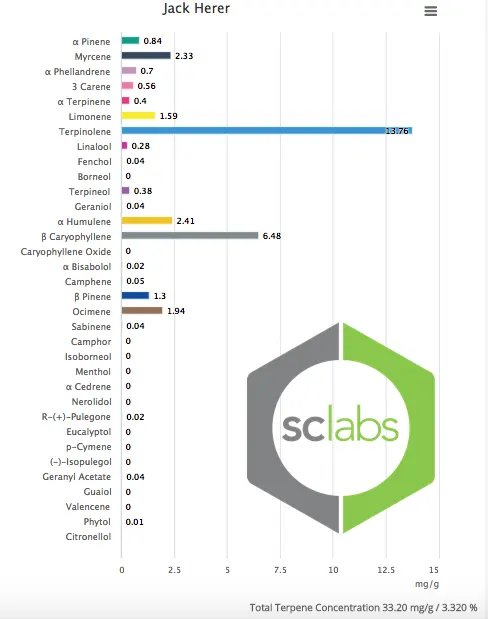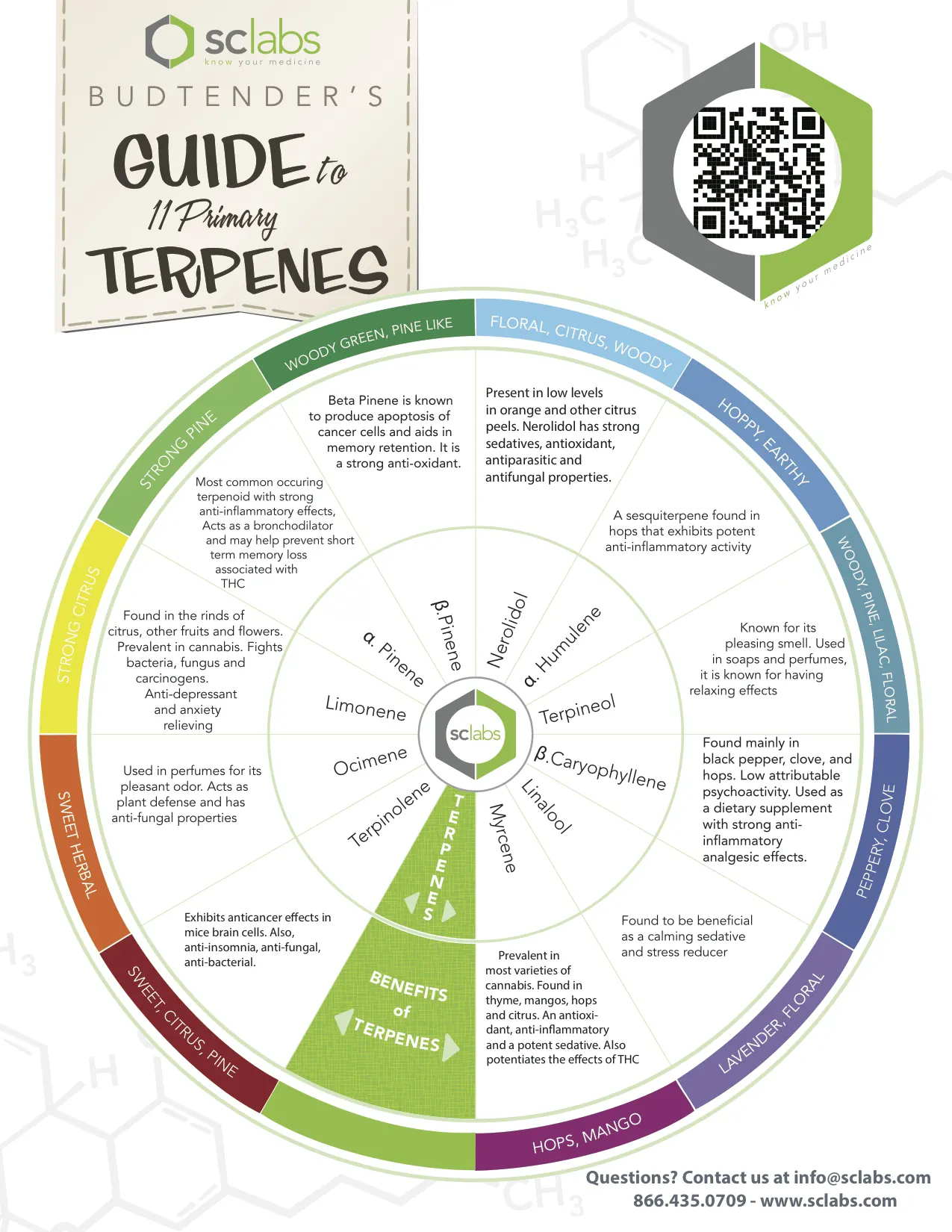Skunky, fruity, floral, the bouquet of smells associated with cannabis can be highly diverse and varied from cultivar to cultivar. This diversity comes from the fragrant molecules found in cannabis called terpenes. There are over a hundred different terpenes found in cannabis, which have evolved with the cannabis plant as a defense mechanism against bacteria, fungi, insects, and other pests. They also serve as the building blocks for more complex molecules like the cannabinoids.
The Chemistry of Terpenes
Terpenes are volatile hydrocarbons that carry an aroma and are made up of small five carbon components called isoprene units. There are also similar molecules found in cannabis called terpenoids, which are modified terpenes where oxygen atoms have been incorporated or methyl groups have been added or removed. Often times the term terpenes is used more broadly to include terpenoids. Terpenes can be further categorized into three different subtypes: monoterpenes, diterpenes, and sesquiterpenes.

Photo taken from: http://www.ochempal.org/index.php/alphabetical/i-j/isoprene-unit/
Monoterpenes are the simplest type of terpene and are made up of two isoprene units. An example of a common monoterpene found in cannabis is myrcene, which has been hypothesized to enhance the ability of THC to cross the blood-brain barrier giving certain strains their punch. Myrcene acts as a powerful analgesic and its effects are counteracted by the opiate antagonist naxolone (Narcan) suggesting that its pain relieving properties are due to interactions with the opiate system [1]. Strains that are dominant in myrcene tend to produce sedating effects [2]. Sesquiterpenes are terpenes containing three isoprene units. Perhaps the most common sesquiterpene found in cannabis is β-caryophyllene, the only terpene known to bind to the cannabinoid receptor CB2. Studies in mice show that the actions of β-caryophyllene at this receptor are capable of enhancing the pain relieving and anti-inflammatory actions of the cannabis plant [3-4]. Diterpenes are composed of two monoterpene subunits or four isoprene units. An example of a diterpene is phytol, which is a degradation product of chlorophyll and hence found in nearly all cannabis. This terpene increases the expression of GABA, an inhibitory neurotransmitter associated with relaxing effects, by blocking its degradation. Just beginning to describe the various classes of terpenes you can see the building potential for synergy towards certain effects while antagonizing others.
The Entourage Effect: How terpenes modify the effects of cannabinoids
Dr. Ben Shabat et al demonstrated the earliest evidence of an entourage effect in 1998 with their work on endogenous cannabinoids [5]. This work showed that activity at cannabinoids receptors could be enhanced when there were multiple inactive fatty acid derivatives present. A few years later in 2001, John McPartland and Ethan Russo published a paper titled “Cannabis and Cannabis Extracts: Greater Than the Sum of Their Parts”. This publication extended this entourage concept presenting early evidence that terpenes enhanced the effects of the cannabinoids [6]. This work was further refined later by Russo in August of 2011 when he published “Taming THC: potential cannabis synergy and phytocannabinoid terpene entourage effects” in the British Journal of Pharmacology. This paper proposed that the terpenes in cannabis were capable of modulating the effects of cannabinoids and offered many possible mechanisms by which terpenes could induce this action [7]. The table below shows just some of the terpenoids native to cannabis, their pharmacological activity, as well as the cannabinoids they might synergize with.
Terpenes are capable of reducing undesirable effects while enhancing others. Many of the monoterpenes found in cannabis such as (-)-alpha-pinene, (+)-3-carene, p-cymene, terpineol, and eucalyptol can inhibit the enzyme acetylcholinesterase (AChE) enhancing acetylcholine function, which is an important neurotransmitter involved in memory [8]. This suggests that some of the negative effects of THC on memory could be counteracted if these terpenes are present in significant concentrations. This could be particularly beneficial for conditions such as Alzheimer’s, where a combination of decreased cholinergic function and neuroinflammation leads to the progressive deterioration of memory.
Indica & Sativa
The work of Karl Hillig at the University of Indiana in 2004 was the first to demonstrate that terpene profiles are not a viable means to distinguish between different cannabis species. His work, along with Russo and McPartland’s completely changed the world of cannabis by changing the way we classify the effects of strains. For decades the terms indica and sativa have been applied to suggest a couch-lock or uplifting effect respectively, however these labels are often incorrect and merely reflect the plants morphology and growth patterns. For example, one could have a plant that grows short and squat like an indica but is dominant in limonene and pinene which are associated with more energizing strains. There are likely many classes of cannabis based on the dominant terpenes present rather than three main categories of cannabis (indica, sativa, hybrid). To further dispel the indica sativa myth, one of the most popular “sativa” varietals is Jack Herer. The dominant terpene in this strain is terpinolene, which has been shown in studies to have a sedating effect, completely the opposite of what one would call uplifting [9-10].
|
Terpenoid |
Found In |
Pharmacological Activity |
Synergistic Cannabinoid |
|
Limonene |
Lemon |
1. Immunostimulant when inhaled
2.Anxiolytic via 5HT-1A 3.Apoptosis of breast cancer cells 4.Effective against acne causing bacteria 5.Dermatophytes 6.Gastro-oesophageal reflux
|
1. CBD
2. CBD 3. CBD, CBG 4. CBD 5. CBG 6. THC |
|
Pinene |
Pine |
1. Anti-inflammatory via PGE-1
2. Bronchodilatory in humans 3. Acetycholinesterase inhibitor, aiding memory |
1. CBD 2. THC 3. CBD, THC?
|
|
Myrcene |
Hops |
1.Blocks inflammation via PGE-2
2.Analgesic, antagonized by naxolone 3.Sedating, muscle relaxant, hypnotic 4.Blocks hepatic carcinogenesis by aflatoxin |
1. CBD
2. CBD & THC 3. THC 4. CBD & CBG |
|
Linalool |
Lavender |
1.Anti-anxiety
2.Sedative upon inhalation in mice 3.Local anesthetic 4.Analgesic via adenosine A2A 5.Anticonvulsant/anti-glutamate 6.Potent anti-leishmanial |
1. CBD, CBG?
2. THC 3. THC 4. CBD 5. CBD, THCV, CBDV 6. ? |
|
Beta Caryophyllene |
Black Pepper |
1.Anti-inflammatory via PGE-1
2.Gastric cytoprotective 3.Anti-malarial 4.Selective CB2 agonist 5.Treament of pruritus 6. Treatment of addiction |
1. CBD
2. THC 3. ? 4. THC 5. THC 6. CBD
|
|
Caryophyllene Oxide |
Lemon Balm |
1.Decreases platelet
aggregation 2.Antifungal in Onchyomycosis comparable to ciclopiroxolamine and sulconazole 3.Insecticidal/anti-feedant |
1. THC
2. CBC & CBG 3. THCA & CBGA |
|
Nerolidol |
Orange |
1.Sedative
2.Skin penetrant 3.Potent antimalarial 4.Anti-leishmanial activity |
1. THC & CBN
2. – 3. ? 4. ? |
|
Phytol |
Green Tea |
1.Breakdown of chlorophyll
2.Prevents vitamin A teratogenesis 3. ↑GABA via SSADH inhibition |
1. –
2. – 3. CBG |

Terpene Tailoring: Formulating the right medicine for your condition
This deeper understanding of cannabinoid and terpenoid synergy has allowed for the optimization of cannabis therapeutics. Breeders can now create varieties that produce enhanced benefits by crossing strains with terpene profiles that are known to be effective for certain ailments. In the realm of extractions many processors have begun adding isolated terpenes to their products to boost certain desired effects. For example, if one had gut inflammation they might add additional β-caryophyllene to the final product since it elicits its anti-inflammatory action via the CB2 receptor, which is widely expressed in the gastrointestinal tract [11]. While these are great ideas based on our current understanding, further studies are needed to hone in on the most beneficial terpene profiles for a given condition.
References
- Rao VS, Menezes AM, Viana GS. Effect of myrcene on nociception in mice. J Pharm Pharmacol. 1990;42(12):877-8.
- Russo EB. Treatment with cannabis and cannabinoids: Some practical aspects and controversies. O’Shaugnessy’s Winter Issue 2016
- Gertsch J, Leonti M, Raduner S, et al. Beta-caryophyllene is a dietary cannabinoid. Proc Natl Acad Sci USA. 2008;105(26):9099-104.
- Klauke AL, Racz I, Pradier B, et al. The cannabinoid CB₂ receptor-selective phytocannabinoid beta-caryophyllene exerts analgesic effects in mouse models of inflammatory and neuropathic pain. Eur Neuropsychopharmacol. 2014;24(4):608-20.
- Ben-shabat S, Fride E, Sheskin T, et al. An entourage effect: inactive endogenous fatty acid glycerol esters enhance 2-arachidonoyl-glycerol cannabinoid activity. Eur J Pharmacol. 1998;353(1):23-31.
- McPartland, J.M. and Russo, E.B. 2001. Cannabis and Cannabis extracts: greater than the sum of their parts? Journal of Cannabis Therapeutics 1:103-132.
- Russo EB. Taming THC: potential cannabis synergy and phytocannabinoid-terpenoid entourage effects. Br J Pharmacol. 2011;163(7):1344-64.
- Miyazawa M, Yamafuji C. Inhibition of acetylcholinesterase activity by bicyclic monoterpenoids. J Agric Food Chem. 2005;53(5):1765-8.
- Hillig, Karl W. A chemotaxonomic analysis of terpenoid variation in Cannabis. Biochemical systematics and ecology 32.10 (2004): 875-891
- Ito K, Ito M. Sedative effects of vapor inhalation of the essential oil of Microtoena patchoulii and its related compounds. J Nat Med. 2011;65(2):336-43.
- Wright KL, Duncan M, Sharkey KA. Cannabinoid CB2 receptors in the gastrointestinal tract: a regulatory system in states of inflammation. Br J Pharmacol. 2008;153(2):263-70.

